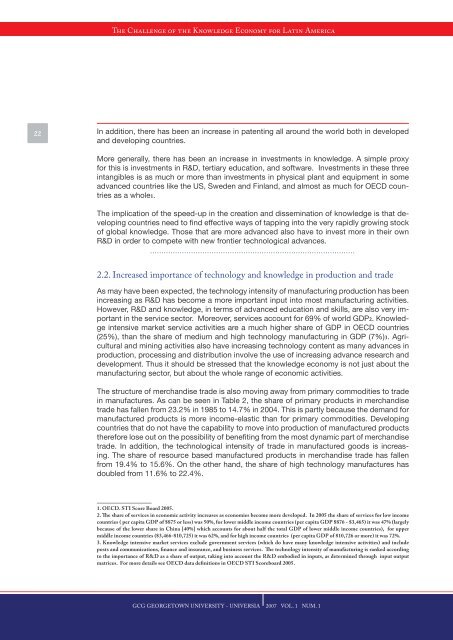2007 Vol. 1 Num. 1 - GCG: Revista de Globalización, Competitividad ...
2007 Vol. 1 Num. 1 - GCG: Revista de Globalización, Competitividad ...
2007 Vol. 1 Num. 1 - GCG: Revista de Globalización, Competitividad ...
Create successful ePaper yourself
Turn your PDF publications into a flip-book with our unique Google optimized e-Paper software.
The Challenge of the Knowledge Economy for Latin America<br />
22 In addition, there has been an increase in patenting all around the world both in <strong>de</strong>veloped<br />
and <strong>de</strong>veloping countries.<br />
More generally, there has been an increase in investments in knowledge. A simple proxy<br />
for this is investments in R&D, tertiary education, and software. Investments in these three<br />
intangibles is as much or more than investments in physical plant and equipment in some<br />
advanced countries like the US, Swe<strong>de</strong>n and Finland, and almost as much for OECD countries<br />
as a whole1.<br />
The implication of the speed-up in the creation and dissemination of knowledge is that <strong>de</strong>veloping<br />
countries need to find effective ways of tapping into the very rapidly growing stock<br />
of global knowledge. Those that are more advanced also have to invest more in their own<br />
R&D in or<strong>de</strong>r to compete with new frontier technological advances.<br />
2.2. Increased importance of technology and knowledge in production and tra<strong>de</strong><br />
As may have been expected, the technology intensity of manufacturing production has been<br />
increasing as R&D has become a more important input into most manufacturing activities.<br />
However, R&D and knowledge, in terms of advanced education and skills, are also very important<br />
in the service sector. Moreover, services account for 69% of world GDP2. Knowledge<br />
intensive market service activities are a much higher share of GDP in OECD countries<br />
(25%), than the share of medium and high technology manufacturing in GDP (7%)3. Agricultural<br />
and mining activities also have increasing technology content as many advances in<br />
production, processing and distribution involve the use of increasing advance research and<br />
<strong>de</strong>velopment. Thus it should be stressed that the knowledge economy is not just about the<br />
manufacturing sector, but about the whole range of economic activities.<br />
The structure of merchandise tra<strong>de</strong> is also moving away from primary commodities to tra<strong>de</strong><br />
in manufactures. As can be seen in Table 2, the share of primary products in merchandise<br />
tra<strong>de</strong> has fallen from 23.2% in 1985 to 14.7% in 2004. This is partly because the <strong>de</strong>mand for<br />
manufactured products is more income-elastic than for primary commodities. Developing<br />
countries that do not have the capability to move into production of manufactured products<br />
therefore lose out on the possibility of benefiting from the most dynamic part of merchandise<br />
tra<strong>de</strong>. In addition, the technological intensity of tra<strong>de</strong> in manufactured goods is increasing.<br />
The share of resource based manufactured products in merchandise tra<strong>de</strong> has fallen<br />
from 19.4% to 15.6%. On the other hand, the share of high technology manufactures has<br />
doubled from 11.6% to 22.4%.<br />
1. OECD. STI Score Board 2005.<br />
2. The share of services in economic activity increases as economies become more <strong>de</strong>veloped. In 2005 the share of services for low income<br />
countries ( per capita GDP of $875 or less) was 50%, for lower middle income countries (per capita GDP $876 - $3,465) it was 47% (largely<br />
because of the lower share in China [40%] which accounts for about half the total GDP of lower middle income countries), for upper<br />
middle income countries ($3,466-$10,725) it was 62%, and for high income countries (per capita GDP of $10,726 or more) it was 72%.<br />
3. Knowledge intensive market services exclu<strong>de</strong> government services (which do have many knowledge intensive activities) and inclu<strong>de</strong><br />
posts and communications, finance and insurance, and business services. The technology intensity of manufacturing is ranked according<br />
to the importance of R&D as a share of output, taking into account the R&D embodied in inputs, as <strong>de</strong>termined through input output<br />
matrices. For more <strong>de</strong>tails see OECD data <strong>de</strong>finitions in OECD STI Scoreboard 2005.<br />
<strong>GCG</strong> GEORGETOWN UNIVERSITY - UNIVERSIA <strong>2007</strong> VOL. 1 NUM. 1















